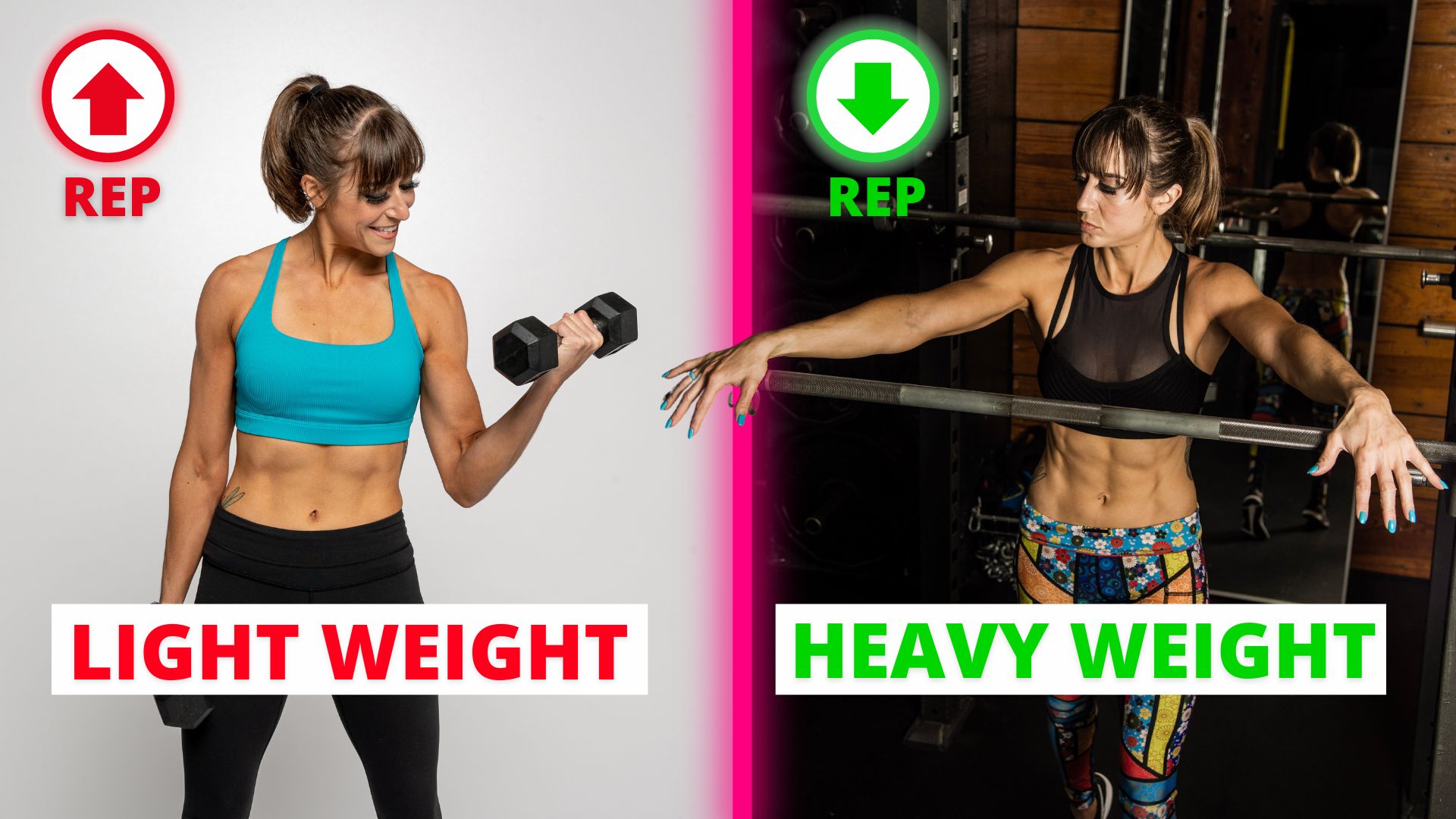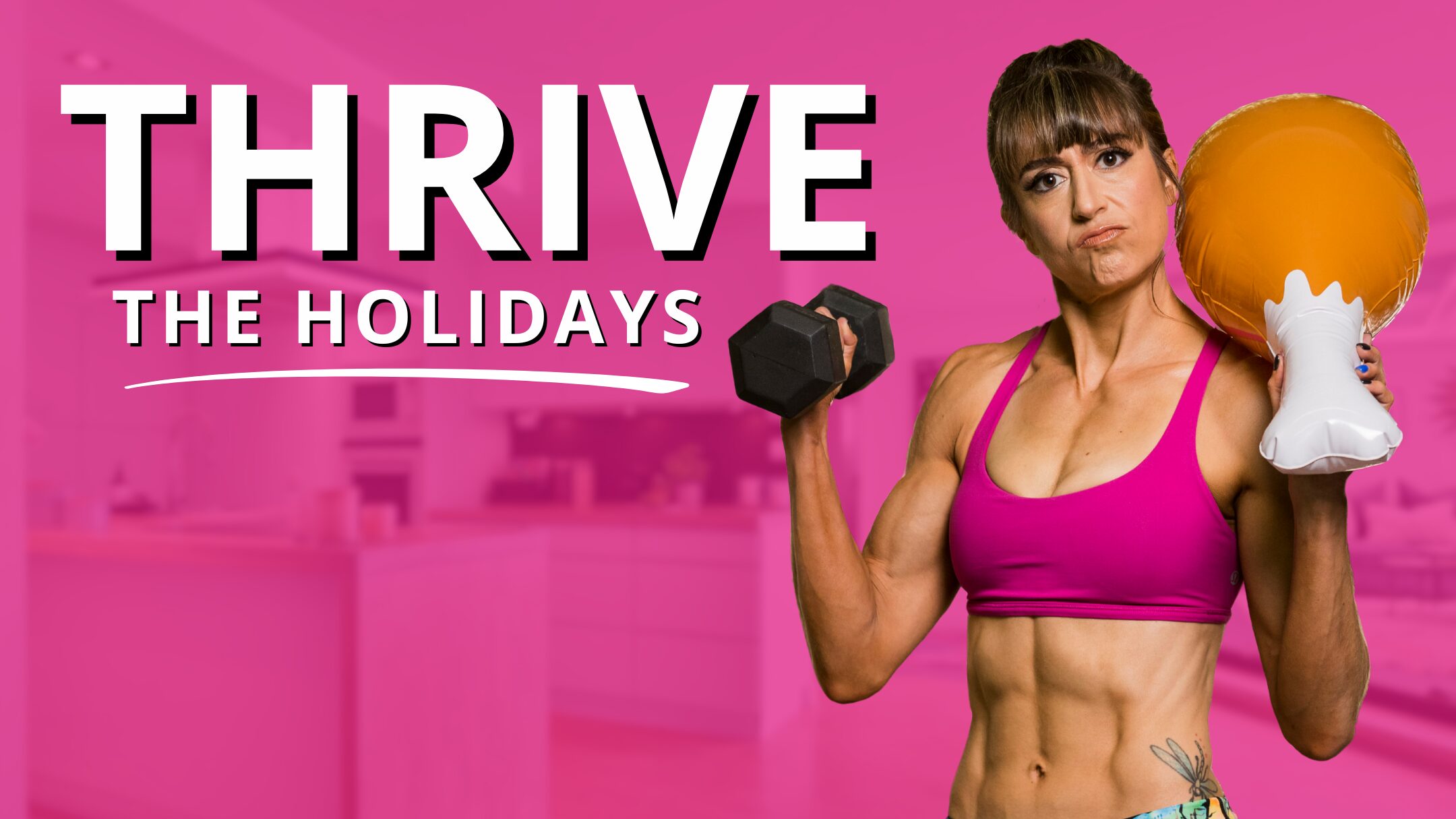LISTEN HERE
WATCH HERE
TRANSCRIPT
OPEN TRANSCRIPT
Hey guys, this is Cori from Redefining Strength. Welcome to the Fitness Hacks Podcast. This is a show where I share all my free workout and nutrition tips. I’m not going to ever fill this episode with sponsorships or ask you to buy anything. All I ask in return is if you’re enjoying the podcast to leave a review or leave a five star rating or even better share with somebody you think it might help. This will only take a few minutes and would mean the world to me and possibly change the life of someone you know. So let’s jump right in.
What’s best if I want to gain muscle and lose fat, lower reps and heavier weights or higher reps and lighter weights? The first annoying answer is it depends because really exactly what our training experience is, how we’re designing our workouts in terms of other cardio we’re including is going to impact what we really need. But on top of that, it’s usually not either or. It’s not just, oh, do lower reps, or, oh, just do higher reps. The best results often happen when we use a combination and how we exactly combine those things will be based on our training experience, our schedule, exactly what we want to achieve in terms of that muscle growth or that fat loss. But you need a diversity of ranges in your workout routines if you want to see the best results as fast as possible because they drive muscle growth generally in different ways.
Not to mention, the stronger we make ourself with some of that lower rep work, the more loads we can lift with those higher reps to really challenge ourself, take our muscles closer to failure and see results build. Now when I’m talking about failure, I’m not talking about leaving yourself destroyed and slaughtered and so sore. You can’t move the next day. That’s not necessary from muscular failure. You want to recover from your training. You want to create that slow progression week over week because if you’re constantly destroying yourself and you’re not able to recover fast enough to train hard the next session, you’re going to see a point of diminishing returns. You’re probably going to get injured. Soreness is not the best indicator of growth. It generally means that something is off in our recovery even so while you’re trying to use the diversity of ranges, it’s not just to destroy yourself, but you want to include a diversity of ranges to use all three drivers of muscle growth.
Because in trying to use different rep ranges, you’re going to use the diversity of movements and different tools as well, but you’re going to drive muscle growth through using muscle tissue damage, mechanical tension, and metabolic stress, which are all three drivers. So when we’re talking about using a diversity of rep ranges, you want to use lower reps and heavier weights with compound moves, and then you might even want to use higher reps with lighter loads than the heavy loads, but still challenging. No loads should ever feel light, but you’re going to use potentially more isolated movements. And when we often think about using a diversity of rep ranges, we think about over the week, not just in a single workout, but you do sometimes want to in the same workout, use multiple different rep ranges. You might do one to five with maximal strength, six to 12 with hypertrophy, and then that 15 to 20 strength endurance rep range.
And all those can have benefit. And often when we do include them in a single session, we do so in a very traditional way of putting the lower rep compound, move heavier lifts at the start, and then the more isolated exercises at the end. So maybe we do our barbell row at the start of the workout and that bicep curl at the end of the workout, and then more isolated movement. We do higher reps because we can isolate the muscle with that, and it’s not as strong or big a muscle group as potentially we’re using with the compound lift to start like the ben over row. But this is only one way you can combine ranges. Another great way is, especially if you’re going through perimenopause or menopause or even post-menopausal, and you’re struggling to see the same muscle gains that you did when you were younger because our hormone levels just aren’t as optimal as they used to be, and we aren’t as able to use protein as efficiently for muscle growth, you might want to consider something that helps you take those muscles closer to failure and helps create that extra stress, which is that stimulus for muscle growth.
And again, we’re not seeking to be sore or just kill ourselves with our sessions, but you do need to strain muscles and create that extra stimulus when you want to see that same anabolic environment, that same stimulus for muscle growth. So this is where things like the compound burner sets or the 6, 12 25 technique can come into play because you’re using that more compound heavier lift followed up by a movement that isolates one of the muscle groups involved to take it closer to fatigue, but in a way that uses a different driver of muscle growth and in a way that doesn’t leave you just feeling so destroyed from all this muscle tissue damage that you can’t train hard the next day. So if you’re using compound burners, you might use something like a lunge for eight to 12 reps with heavier loads. And then if you’re doing a front lunge and you want to target your quads, you might do a leg extension or some sort of quad isolation movement as the 15 to 20 reps.
And when you’re doing this, you can even push a little bit past failure, which I know sounds weird, but sometimes we get caught in between loads where we can’t necessarily do all the reps with the load, but if we pause for 15 seconds even, we can then pick that weight back up and complete it. That especially for the 15 to 20 rep, more isolated movement can be a great way to really push past that fatigue, recruit more muscle fibers and see better muscle growth. So that’s how you would use it with a compound burner set versus if you use 6, 12, 25, you’re using the low end of that hypertrophy in towards maximal strength for that first move. Again, doing a compound exercise, this is where you can use things like heavy bar ball, hip thrusters, and then maybe for that 12 reps where you’re in that hypertrophy rep range towards the upper end of it, you can even use something like more of a lunge or something that you can still go really heavy on, but not necessarily as heavy as you could with that first compound movement.
And then for the last exercise, the 25 reps, maybe you do something like a kickback to really isolate your glutes even more, but you’re getting more isolated over the movements to target the muscle and push it past fatigue by sort of stepping down in the intensity of the move that you’re doing while still being able to work that area. But this stimulus is great if we really want to see those faster muscle gains. Now note, all of these tools are only as good as our implementation, and if we’re not truly pushing yourself to maximize that time and earn the rest so that we want a minute, 90 seconds, even two minutes between rounds, we shouldn’t feel like the rest is too short. We should feel like I crave this rest. To be able to go at the same intensity, you need to push yourself. So if you’re not pushing yourself at each of these rep ranges to max out even a rep or two before the rep range actually ends, you’re not going to see the same stimulus, you’re not going to see the same results.
But if you are interested in implementing either the techniques I mentioned, I will link to more information on both the 6, 12, 25 and the compound burner sets in the show notes. But remember to use a diversity of ranges in your training if you want to see this best results as fast as possible. And even when you’re doing higher rep or lower rep, no weight should ever feel light. It should always challenge you for the reps assigned and make you want to stop before you hit the top end of the rep range. And if you can hit that top end of the rep range, go heavier and work down in that rep range to really challenge yourself to create that progression week after week to see that muscle growth and ultimately help yourself look leaner, lose that body fat, have a healthier metabolic rate.
Thanks for listening to the Fitness Hacks Podcast. Again, this is the place where I share all my free workout and nutrition tips. I’m never going to run sponsorships or ask you to buy anything. All I ask in return is if you’re enjoying the podcast to leave a rating review or share it with someone you think it might help. This will only take a few minutes and it would mean the world to me and possibly change the life of someone you know.
*Please Note: this transcript is auto-generated and there may be some errors in the transcript





0 Comments